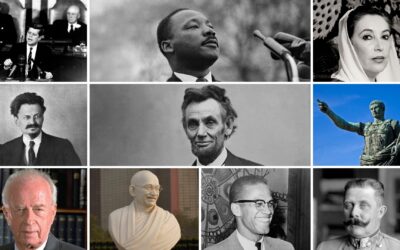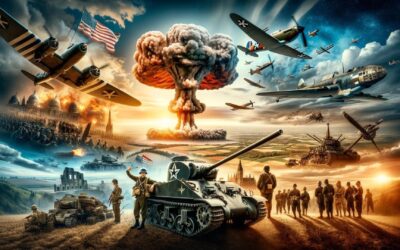In the ominous shadow of a mushroom cloud, a pervasive fear of nuclear annihilation has haunted humanity since the dawn of the atomic age. The threat of nuclear weapons and the looming specter of a nuclear holocaust have deeply penetrated our collective consciousness, inducing what can best be described as “nuclear anxiety.”
The inception of this nuclear anxiety dates back to August 6, 1945, when a blinding flash of light in the skies over Hiroshima, Japan, marked the beginning of the nuclear age. The birth of the atomic bomb, followed three days later by a second bomb over Nagasaki, showed the world the terrifying capabilities of nuclear power. In the immediate aftermath of these events, a tide of fear and anxiety swept across the globe, forever altering our perception of warfare and survival.
The Cold War that followed only intensified this nuclear anxiety. The constant saber-rattling between the United States and the Soviet Union, epitomized by the Cuban Missile Crisis of 1962, brought the world to the brink of nuclear war. The notion of ‘Mutually Assured Destruction’ (MAD), although proposed as a deterrent, had a chilling effect, reinforcing the sense of dread.
This fear found its way into every facet of popular culture during the 20th century. In literature, books like Nevil Shute’s “On the Beach” and Raymond Briggs’ “When the Wind Blows” depicted apocalyptic and post-apocalyptic scenarios following a nuclear war. Movies such as “Dr. Strangelove” and “The Day After” offered harrowing portrayals of nuclear catastrophes. Even music wasn’t immune, with songs like “99 Red Balloons” by Nena and “Russians” by Sting echoing the nuclear fears of the era.
However, the terror of the nuclear age wasn’t limited to abstract cultural expressions. It became a part of daily life. In the United States, ‘duck and cover’ drills became a routine part of school life, while families built fallout shelters in their backyards. In the Soviet Union, citizens were regularly reminded of the looming nuclear threat through civil defense drills and propaganda.
The end of the Cold War didn’t mean an end to nuclear anxiety. Instead, it has morphed and persisted. Today, we worry about nuclear proliferation and the possibility of nuclear weapons falling into the hands of rogue states or non-state actors. Moreover, the environmental impact of nuclear power, highlighted by incidents like the Chernobyl and Fukushima disasters, adds another layer to our nuclear fears.
Living under the shadow of the bomb has had profound psychological impacts. Studies show that the persistent threat of nuclear war can lead to a range of mental health issues, from anxiety and depression to a pervasive sense of helplessness. ‘Nuclear numbing,’ a term coined by psychologists, describes a phenomenon where individuals, overwhelmed by the magnitude of nuclear threats, experience emotional shutdown and apathy.
Despite the pervasiveness of nuclear anxiety, it has also inspired efforts towards peace and disarmament. Anti-nuclear movements have sprung up worldwide, advocating for nuclear disarmament and promoting a vision of a world free from the threat of nuclear annihilation. These movements, fueled by nuclear anxiety, have achieved some successes, such as the Treaty on the Non-Proliferation of Nuclear Weapons (NPT) and the Treaty on the Prohibition of Nuclear Weapons (TPNW).
Yet, the anxiety lingers, a ghostly reminder of the power humans have unleashed. Living in the nuclear age means living with nuclear anxiety, a psychological burden unique to our times. As we navigate this terrain, understanding and addressing this anxiety is critical. We must learn to balance the promise and peril of nuclear power, striving for a world where nuclear energy serves humanity, not terrorizes it.
In this task, we are guided by the haunting words of J. Robert Oppenheimer, the ‘father of the atomic bomb,’ who upon seeing the first atomic test, turned to Hindu scripture, murmuring: “Now I am become Death, the destroyer of worlds.” Let his words serve as a warning and a call to action: a reminder of the destructive power we wield and an appeal for wisdom, caution, and above all, peace.
Keywords:
- Nuclear Anxiety: A pervasive fear of nuclear annihilation or nuclear-related disasters.
- Nuclear Age: A period of history characterized by the existence and potential use of nuclear weapons.
- Mutually Assured Destruction (MAD): A doctrine of military strategy where a full-scale use of nuclear weapons by two opposing sides would cause the complete annihilation of both.
- Cold War: A state of political and military tension after World War II between powers in the Western Bloc (the United States and its allies) and powers in the Eastern Bloc (the Soviet Union and its allies).
- Cuban Missile Crisis: A 13-day confrontation in October 1962 between the United States and the Soviet Union concerning American ballistic missile deployment in Italy and Turkey with consequent Soviet ballistic missile deployment in Cuba.
- Nuclear Proliferation: The spread of nuclear weapons, fissionable material, and weapons-applicable nuclear technology to nations not recognized as “Nuclear Weapon States” by the Treaty on the Non-Proliferation of Nuclear Weapons.
- Fallout Shelters: An enclosed space specially designed to protect occupants from radioactive debris or fallout resulting from a nuclear explosion.
- Chernobyl and Fukushima Disasters: Nuclear accidents at the Chernobyl Nuclear Power Plant in Ukraine (1986) and the Fukushima Daiichi Nuclear Power Plant in Japan (2011) which led to significant releases of radioactive particles into the environment.
- Nuclear numbing: A psychological state where individuals, overwhelmed by the magnitude of nuclear threats, experience emotional shutdown and apathy.
- Treaty on the Non-Proliferation of Nuclear Weapons (NPT) and Treaty on the Prohibition of Nuclear Weapons (TPNW): International treaties with the aim to prevent the spread of nuclear weapons and promote disarmament.
Key Takeaways:
- The dawn of the nuclear age, marked by the bombings of Hiroshima and Nagasaki, introduced a pervasive fear known as nuclear anxiety.
- The Cold War period intensified this anxiety with constant tensions between nuclear-armed superpowers.
- Nuclear anxiety permeated popular culture and everyday life during the 20th century.
- Today, concerns over nuclear proliferation and the environmental impact of nuclear power continue to fuel nuclear anxiety.
- Living under this constant threat can lead to mental health issues and a phenomenon known as ‘nuclear numbing.’
- Despite the pervasive fear, nuclear anxiety has also sparked global movements towards nuclear disarmament and peace.
The Nuclear Age Articles
Unraveling The Atomic Age: The Life and Legacy of J. Robert Oppenheimer
Unveiling the Atom: The Manhattan Project’s Deep Impact on World History
Albert Einstein: The Maverick Mind that Revolutionized Physics
Leo Szilard: The Atomic Pioneer’s Crusade for Peace
The Ethical Odyssey: Exploring Morality in the Course of Scientific Discovery
Los Alamos National Laboratory: Navigating the Past, Present, and Future of Scientific Innovation
The Cold War: Superpowers in the Ballet of Weaponry
Nuclear Proliferation: The Ever-Present Global Challenge
Interplay of Science and Politics: The Unsung Dance of Progress
Enrico Fermi: Mastermind Behind the Nuclear Age
From Atomic To Thermonuclear: A Detailed Examination of Nuclear Weapon Evolution
The Unforgotten Echoes: Hiroshima and Nagasaki’s Tale of Nuclear Devastation and Human Resilience
Living Under the Mushroom Cloud: The Psychological Impact of the Nuclear Age
Nuclear Fallout: Unmasking the Invisible Threat to Health and Environment
The Power and Peril of Nuclear Energy: A Balanced Perspective
Radiation Sickness: Unveiling the Hidden Costs of the Nuclear Age
From Darkness to Light: Lessons from Chernobyl and Fukushima
Deciphering the Nuclear Waste Conundrum: The Path Towards Sustainable Solutions
Guarding the World from Nuclear Threats: International Laws for Nuclear Disarmament
Journey to Peace: Unraveling the Path to Global Nuclear Disarmament
Culture Echoes of the Atomic Age: Artistic Narratives in the Nuclear Era












0 Comments